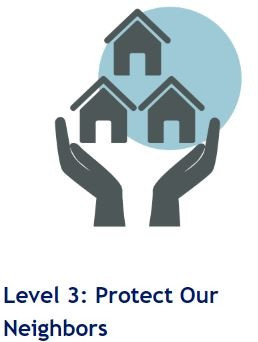SLV finalizing application for Protect Our Neighbor certification

SAN LUIS VALLEY — “Our numbers are looking good.”
Those words, spoken by director of Alamosa County Public Health, Della Cox-Vieira when making a presentation to the Alamosa County Board of Commissioners, are not just good news, they’re the basis on which SLV health officials are applying to the state for certification in “Protect Our Neighbors”, the state program with the least restrictions for qualified communities where the spread of the virus is low.
As the third phase in a program that began with “Stay at Home” and “Safer at Home”, certification in “Protect Our Neighbors” is a rigorous process largely dependent on three basic sets of numbers: testing positivity, numbers of new cases – excluding outbreaks — and stable or decreasing hospitalizations.
As part of the application to be certified, counties have to provide detailed plans outlining what steps they would take if those good numbers started going south, including a plan of action to mitigate and contain an increase in cases and/or hospitalizations as well as a plan of action in case there’s a surge.
Even while being at the forefront of dealing with a pandemic in progress, public health officials and stakeholders have put significant work over the last two months into creating the plans the application reflects. But the program, which Polis described as “good news”, has provisions that begin to resemble a life that’s a little more normal.
“Protect Our Neighbors”, as unveiled by Governor Polis in mid-June, eliminates the need for sector-specific variances and allows “all activities” to resume at 50% of pre-pandemic capacity with up to 500 people in one setting as long as social distancing measures are in place. That includes places of worship, restaurants, bars, retail stores, non-critical manufacturing, offices and personal services to operate at 50% capacity. The same 50% capacity figure is allowed for group sports and camps. It also allows for in-person instruction – from pre-school to grade 12 and higher education -- again, with social distancing in place.
Also, the program has one additional key component. If a county continues to meet all the metrics required by the program, communities can gradually increase their 50% threshold by 5% for each month they are compliant.
In other words, if a county has six consecutive months of “good numbers”, that 50% capacity will have increased to 80%, 5% at a time. Another four months and businesses can operate at 100% of pre-pandemic capacity.
Unlike any other applicants in the state, the decision was made for the San Luis Valley to apply for certification as a region, including all six counties in the application process: Alamosa, Conejos, Costilla, Mineral, Rio Grande and Saguache.
Cox-Vieira attributed the decision to several factors. Applying as a region provides better economic stability across the valley. It reduces confusion by having one central message going out. It also makes the most sense for the health care system that’s in place and the common situations where people live in one county but work in another.
Cox-Vieira clarified that, although the six counties will collectively submit one application for the SLV, each county will be responsible for maintaining their compliance. Should they not, the region goes in and out of the program as a whole; a county cannot fall below the minimum numbers set while the rest of the valley stays in. “It’s an all in or all out scenario.”
Once the SLV has been certified, information about the program will be rolled out to let residents and businesses know what’s involved. That rollout will also stress that the factors that got the SLV to good numbers must stay in place, including the use of face masks, social distancing, sanitization and staying home if feeling sick.
Cox-Vieira said the goal is to submit the application on October 9. As a final step, county public health directors are requesting “Letters of Attestation” from hospitals, police departments, public health, commissioners, emergency managers, mayors and sheriffs.
At this point, all six county public health directors are unanimous in their support of a regional application. However, if local leadership does not sign on, those remaining counties where leadership is in support will continue with the process.
After her presentation, the board of commissioners discussed writing a letter of attestation in support of the application with the understanding that they, as a board, would be responsible for continuing to demonstrate support as the program continues.
Prior to the vote, Commissioner Allen expressed frustration with what seemed like inconsistent data posted in different places, stating that “5% a month doesn’t help small restaurants and churches that much…but something is better than nothing.”
With that said, he then introduced the motion to write a letter of attestation, which was unanimously approved.
It’s not known at this time when the state will notify the SLV group of their decision, but Cox-Vieira stated that it shouldn’t be too long, given the amount of work the group had invested in developing plans.



